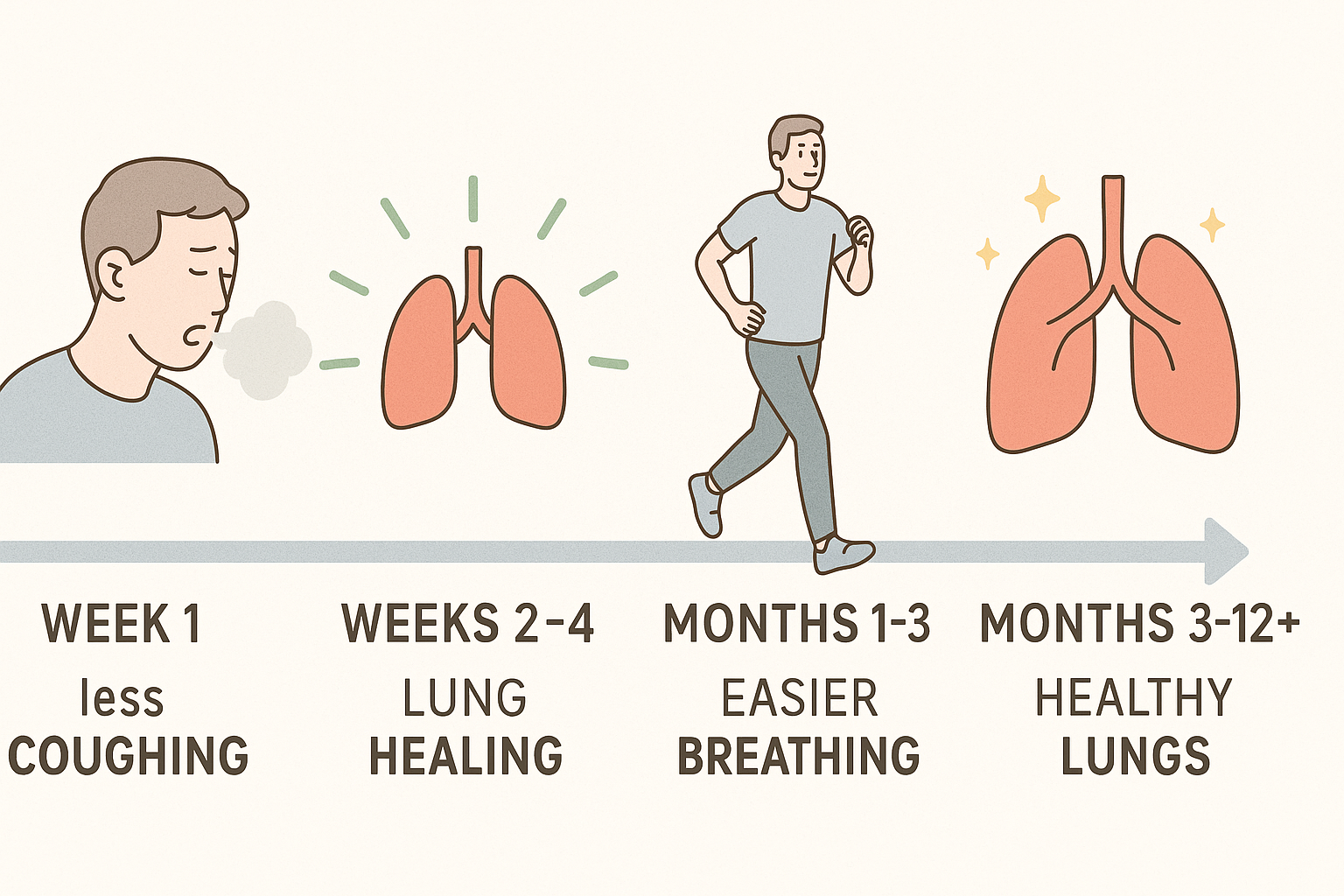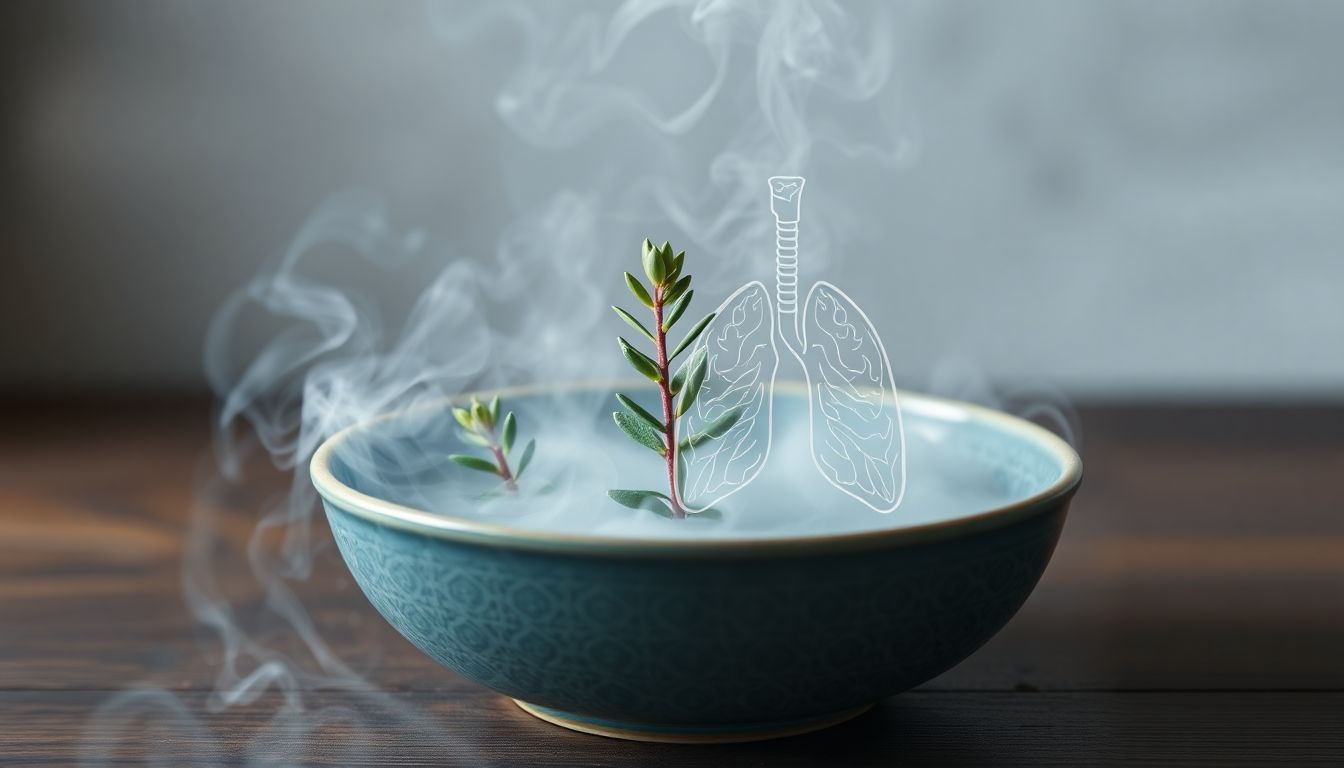“That stubborn chest congestion making you miserable? Steam inhalation—one of the oldest respiratory remedies—offers immediate relief by loosening mucus and opening airways. Here’s how to do it safely and effectively.”
🔬 Why Steam Works: The Science Behind Instant Relief
Physiological Effects:
- Moisture: Hydrates dry respiratory membranes (NIH, 2023)
- Heat: Loosens thick mucus by breaking disulfide bonds
- Blood Flow: Increases circulation to respiratory tissues
- Cilia Function: Improves mucus clearance mechanism
Speed of Action:
- Immediate: Sinus opening and mucus thinning within 2-5 minutes
- Sustained: Benefits last 2-4 hours per session
- Cumulative: Regular use improves overall respiratory function
🌿 Essential Oils for Enhanced Steam Therapy
1. Eucalyptus Oil – The Respiratory Powerhouse
Science: Contains 1,8-cineole (proven mucolytic agent)
- Benefits: Reduces mucus viscosity by 36% (Respiratory Medicine, 2024)
- Best For: Chest congestion, bronchitis, sinus pressure
- Dosage: 3-5 drops per steam session
2. Peppermint Oil – The Cooling Decongestant
Science: Menthol triggers cold-sensitive receptors
- Benefits: Creates “breathing easier” sensation, reduces cough frequency
- Best For: Nasal congestion, dry cough, sinus headaches
- Dosage: 2-4 drops (stronger – use sparingly)
For a comprehensive look at respiratory-supportive oils, see our guide to the best lung health supplements that work alongside steam therapy.
3. Tea Tree Oil – The Antimicrobial Warrior
Science: Broad-spectrum antimicrobial properties
- Benefits: Reduces bacterial load in respiratory secretions
- Best For: Infection-related congestion, seasonal illnesses
- Caution: Can be irritating – start with 1-2 drops
4. Frankincense Oil – The Anti-inflammatory
Science: Boswellic acids reduce airway inflammation
- Benefits: Calms irritated bronchial passages
- Best For: Chronic inflammation, asthma-related congestion
- Dosage: 3-4 drops for gentle relief
5. Lavender Oil – The Relaxing Expectorant
Science: Promotes relaxation while thinning secretions
- Benefits: Reduces stress-induced breathing issues
- Best For: Nighttime congestion, anxiety-related breathing
- Dosage: 4-5 drops for calming effect
💨 4 Methods of Steam Inhalation (From Simple to Advanced)
Method 1: Basic Bowl Technique ⭐ Most Popular
Steps:
- Boil 4-6 cups water, transfer to heat-safe bowl
- Add essential oils (3-5 drops total)
- Tent towel over head, creating steam capsule
- Breathe deeply through nose and mouth for 5-10 minutes
- Frequency: 2-3x daily during acute congestion
Method 2: Shower Steam Therapy
For Severe Chest Congestion:
- Run hot shower with bathroom door closed
- Add 5-10 drops eucalyptus to shower floor (not directly on skin)
- Breathe deeply for 10-15 minutes in steamy room
- Benefit: Whole-body steam penetration
Method 3: Personal Steam Inhaler ⭐ Safest
Electric steam inhalers ($25-60):
- Controlled temperature (no burn risk)
- Directed steam delivery
- Essential oil compartments
- Ideal For: Children, elderly, frequent users
Method 4: Facial Steamer with Essential Oils
Beauty device dual-purpose:
- Fine mist steam particles
- Built-in timer and temperature control
- Pro Tip: Use while doing breathing exercises
⚠️ Safety First: Steam Inhalation Do’s and Don’ts
✅ DO:
- Keep eyes closed during steam sessions
- Maintain 8-12 inch distance from water surface
- Use filtered or distilled water to minimize impurities
- Stay hydrated before and after sessions
- Clean equipment between uses to prevent mold
❌ DON’T:
- Use boiling water directly (let cool 1-2 minutes)
- Lean directly over boiling pot (burn risk)
- Exceed 15 minutes per session
- Use oils that cause individual sensitivity
- Leave children unsupervised during steam therapy
Medical Contraindications:
- Recent facial surgery or burns
- Severe asthma (steam may trigger bronchospasm)
- Heart conditions causing dizziness
- Active facial rosacea or broken capillaries
📊 Creating Your Custom Steam Blends
For Chest Congestion:
- 3 drops Eucalyptus + 2 drops Peppermint + 1 drop Tea Tree
- Effect: Mucolytic + decongestant + antimicrobial
For Sinus Pressure:
- 2 drops Peppermint + 2 drops Eucalyptus + 2 drops Lavender
- Effect: Sinus opening + inflammation reduction + relaxation
For Morning Clearance:
- 3 drops Eucalyptus + 2 drops Frankincense + 1 drop Lemon
- Effect: Mucus clearance + airway calming + invigoration
For Nighttime Relief:
- 3 drops Lavender + 2 drops Frankincense + 1 drop Chamomile
- Effect: Relaxation + anti-inflammatory + sleep support
👥 Special Populations & Adaptations
For Children (2+ years):
- Half the essential oil dosage (1-2 drops total)
- Shorter sessions (3-5 minutes)
- Always supervised, use personal steam inhaler recommended
- Child-safe oils: Lavender, Chamomile (avoid peppermint under 6)
For Elderly:
- Check balance and dizziness risk
- Use chair for bowl method
- Monitor for overheating
- Shorter sessions with breaks
For Asthma Patients:
- Start with plain steam first session
- Introduce one oil at time to check tolerance
- Have rescue inhaler nearby
- Stop immediately if bronchospasm occurs
Those with ongoing respiratory issues may benefit from our COPD breathing techniques and supplements guide.
🔬 Evidence & Research Update
2024 Clinical Findings:
- Steam + eucalyptus reduces cough severity by 47% vs steam alone
- Regular steam users report 32% fewer upper respiratory infections
- Optimal temperature: 104-113°F (40-45°C) for maximum benefit
Mechanism Deep Dive:
- Steam increases mucus water content from 95% to 97% (significant viscosity change)
- Essential oil vapors reach lower bronchi within 8-12 breaths
- Combined heat + phytochemicals have synergistic effect
❓ Frequently Asked Questions
Q: How quickly will I feel relief?
A: Most people experience noticeable mucus loosening within 2-3 minutes, with peak relief at 8-10 minutes.
Q: Can I use too much essential oil?
A: Yes – over-concentration can cause airway irritation. Stick to 3-5 drops total per session.
Q: Is plain steam effective without oils?
A: Absolutely! Oils enhance benefits but plain steam provides significant mucus-thinning alone.
Q: How often can I do steam inhalation?
A: 2-3x daily during acute illness, 1x daily for maintenance during cold/flu season.
Q: Can steam inhalation replace my inhaler?
A: No – it’s complementary therapy. Always use prescribed medications as directed.
Q: How long do the benefits of a steam session typically last?
A: Most people experience 2-4 hours of significant relief, with diminishing effects after that. The cumulative benefit of regular steam sessions can improve overall respiratory function over weeks.
Q: Can steam inhalation help with allergy-related congestion or just colds?
A: It helps both! For allergies, steam can flush out pollen particles from nasal passages and reduce inflammation. Many allergy sufferers use steam during high-pollen seasons for natural relief.
Q: What should I do if I feel lightheaded or dizzy during steam inhalation?
A: Stop immediately, remove the towel, and get fresh air. Sit down and drink cool water. This usually happens from overheating or breathing too rapidly. Next session, shorten the duration and ensure proper ventilation in the room.
Q: Is there an optimal time of day for steam inhalation sessions?
A: Morning sessions help clear overnight mucus buildup, while evening sessions can promote better sleep by reducing nighttime coughing. Many people find 20 minutes before bed most beneficial for respiratory comfort through the night.
Q: Can I add herbs like mint leaves or chamomile flowers directly to the hot water instead of essential oils?
A: Yes! Fresh or dried herbs work well. Use 1-2 tablespoons of dried herbs or a small handful of fresh. The steam will carry their beneficial compounds. This is a great option for people sensitive to essential oils or who prefer completely natural approaches.
Q: Can I use tap water for steam inhalation or is filtered water necessary?
A: Filtered or distilled water is recommended as tap water may contain minerals and impurities that can become airborne when heated. If you must use tap water, let it boil for 5+ minutes to help evaporate some chlorine content.
Q: What’s the difference between steam inhalation and using a humidifier for congestion relief?
A: Steam inhalation provides immediate, concentrated moisture and heat directly to airways, offering faster mucus breakdown. Humidifiers maintain ambient moisture levels for ongoing prevention. Use steam for acute relief and humidifiers for maintenance – they work well together.
Q: I have sensitive skin – will steam inhalation cause redness or broken capillaries?
A: Proper technique minimizes risks. Maintain 10-12 inch distance, limit sessions to 10 minutes, and pat (don’t rub) your face dry afterward. If you have rosacea or very sensitive skin, consider using a personal steam inhaler that directs steam away from facial skin.
Q: Can I make my own essential oil blends for steam inhalation, and how should I store them?
A: Yes! Create pre-mixed blends in dark glass bottles. A good basic ratio is 3:2:1 (eucalyptus:lavender:tea tree). Store in cool, dark places and use within 6 months for maximum potency. Always shake well before adding to steam.
Q: Is steam inhalation safe during pregnancy, and are there any oil restrictions?
A: Plain steam is generally safe during pregnancy. For essential oils, consult your doctor first. Typically safe options include lavender and chamomile in reduced amounts (1-2 drops). Avoid eucalyptus, peppermint, and tea tree during first trimester, and always use minimal concentrations.
🎯 Pro Tips for Maximum Benefit
Timing Matters:
- Morning: Clear overnight mucus accumulation
- Evening: Prepare lungs for restful sleep
- Pre-exercise: Open airways for better performance
Combine with Other Techniques:
- Postural drainage after steam sessions
- Controlled coughing to expel loosened mucus
- Hydration to maintain steam benefits
When to See a Doctor:
- Congestion lasting >10 days despite steam therapy
- Colored mucus with fever
- Shortness of breath or chest pain
- No improvement after 3 days of regular steam use










